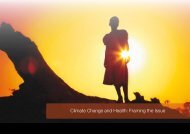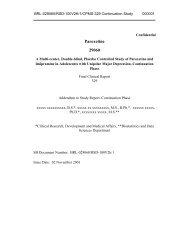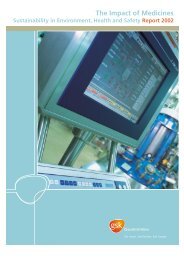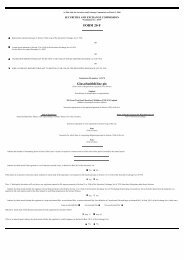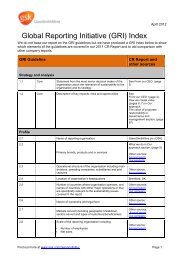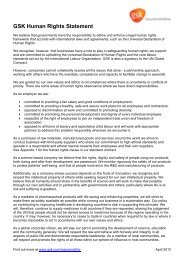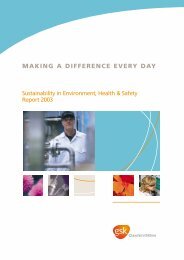GSK Annual Report 2002
GSK Annual Report 2002
GSK Annual Report 2002
You also want an ePaper? Increase the reach of your titles
YUMPU automatically turns print PDFs into web optimized ePapers that Google loves.
66 GlaxoSmithKline Operating and financial review and prospects<br />
2001 Year<br />
In accordance with US SEC disclosure requirements, the following<br />
discussion compares results for the year to 31st December 2001<br />
with the results for the year to 31st December 2000.<br />
Exchange<br />
On average during 2001 sterling exchange rates were weaker<br />
against the US dollar and the Euro and stronger against the Yen<br />
compared with 2000. In aggregate, currency movements in 2001<br />
compared with 2000 had a net favourable effect on sterling<br />
results of two per cent in respect of sales and five per cent in<br />
respect of business performance earnings per share.<br />
Pharmaceutical sales<br />
Total pharmaceutical sales in 2001 were £17,205 million compared<br />
to £15,429 million in 2000, an increase of nine per cent. On a like<br />
for like basis, if sales of products divested in 2000 as part of the<br />
regulatory approval for the merger of Glaxo Wellcome and<br />
SmithKline Beecham were excluded, sales grew 12 per cent from<br />
£14,982 million in 2000. Approximately one per cent of this<br />
overall growth came from price increases.<br />
Within GlaxoSmithKline’s existing portfolio, sales of new products,<br />
those launched in a major market within the last five years,<br />
accounted for 22 per cent of total sales and grew by 48 per cent<br />
to £3,709 million. Sales of the more established, franchise products<br />
amounted to £9,481 million representing 55 per cent of total<br />
sales and growth of 11 per cent compared to last year. Older<br />
products, less actively promoted, at £4,015 million accounted for<br />
23 per cent of total sales, and declined by seven per cent.<br />
Pharmaceutical sales growth in the fourth quarter of 2001 was<br />
12 per cent to £4,719 million, with sales in the USA contributing<br />
£2,466 million; a growth of 15 per cent. Although US wholesaler<br />
buying patterns distorted some product sales, total reported sales<br />
growth was in line with underlying demand as indicated by<br />
prescription data. In Europe sales improved five per cent to<br />
£1,228 million, and in International sales improved 13 per cent<br />
to £1,025 million.<br />
Pharmaceutical sales by therapeutic area<br />
Central nervous system<br />
This major therapeutic area in GlaxoSmithKline’s portfolio recorded<br />
a sales growth of 16 per cent. Seroxat/Paxil and Wellbutrin drove<br />
sales growth in the anti-depressant sector up 20 per cent. In April<br />
2001 Paxil was approved by the US FDA for the treatment of<br />
generalised anxiety disorder (GAD) and in December for the<br />
treatment of post-traumatic stress disorder (PTSD). Seroxat/Paxil is<br />
now approved in 28 countries for the treatment of GAD and in<br />
20 countries for the treatment of PTSD. Wellbutrin sales were<br />
driven by US sales growth of 37 per cent, as a result of increased<br />
awareness amongst physicians of its efficacy and favourable side<br />
effect profile in non-anxious depressed patients.<br />
In the migraine sector the successful launch in Japan of Imigran<br />
Tablets 50, where this treatment had previously been available only<br />
as an injection, helped Imigran/Imitrex sales grow by four per cent.<br />
Lamictal for the treatment of epilepsy grew strongly as did sales<br />
of Requip for Parkinson’s disease. Zyban the smoking cessation<br />
product was launched in France.<br />
Respiratory<br />
The successful launch of the asthma treatment Seretide/Advair<br />
in the USA and in a number of further countries in Europe and<br />
International helped boost sales growth. This product, a<br />
combination of Flixotide/Flovent and Serevent, is available in 36<br />
countries. Worldwide sales of Seretide/Advair exceeded $1 billion<br />
in 2001. In the USA three million prescriptions were written in the<br />
nine months following its launch in April 2001. The speed at<br />
which patients adopted Seretide/Advair in the USA made it one<br />
of the most successful pharmaceutical product launches ever.<br />
Seretide/Advair was GlaxoSmithKline's largest product in Europe<br />
with sales of £441 million in 2001.<br />
An application for the EU registration of Seretide for the treatment<br />
of chronic obstructive pulmonary disease (COPD) was submitted in<br />
September. In January <strong>2002</strong>, an FDA Advisory Committee<br />
recommended approval of Advair and Flovent for the treatment of<br />
COPD associated with bronchitis. Flixotide and Serevent, as<br />
individual agents, are already approved in several countries for the<br />
treatment of COPD.<br />
As expected, sales of Flixotide/Flovent and Serevent declined in<br />
various markets due to the increased momentum of<br />
Seretide/Advair. Sales of Flixonase/Flonase, used in the treatment<br />
of perennial rhinitis, grew strongly.<br />
The older respiratory products Ventolin and Becotide continued to<br />
decline as patients converted to newer products.<br />
Anti-bacterials<br />
Although overall sales in anti-bacterials showed little growth, the<br />
broad-spectrum antibiotic, Augmentin, was still one of the highest<br />
selling products in the Group’s portfolio and achieved 13 per cent<br />
growth worldwide. Augmentin ES-600 (extra strength) was<br />
launched in the USA in October for the treatment of children with<br />
recurrent or persistent middle ear infections. A submission for FDA<br />
approval of Augmentin XR (extended release) was submitted but<br />
extra data and other information was requested by the FDA.<br />
`<br />
Overall, sales of the older products, Zinnat/Ceftin, Fortum and<br />
Amoxil continued to decline, although sales of Zinnat/Ceftin<br />
grew in Central and Eastern Europe by 13 per cent.<br />
Anti-virals<br />
GlaxoSmithKline continued to expand its leadership in HIV/AIDS<br />
with a global market share of 40 per cent.<br />
Trizivir, GlaxoSmithKline’s new triple combination medicine for<br />
HIV/AIDS available in one tablet, was the key driver of growth<br />
in the HIV/AIDS franchise. It was launched in a number of key<br />
markets during the year including much of Europe, the USA<br />
and Canada.<br />
Sales of Combivir, which is a combination of Epivir and Retrovir,<br />
grew five per cent. The major growth markets were Japan, Asia<br />
Pacific, Middle East, Latin America and Africa.<br />
Sales of Ziagen increased five per cent. Approval was received for<br />
a paediatric indication in October for use in the EU. Ziagen had<br />
been approved already in more than 45 countries worldwide for<br />
the treatment of HIV/AIDS in adults.<br />
Sales of Zeffix, for hepatitis B, grew in all market regions. In the<br />
USA, Zeffix, where it is marketed under the name Epivir-HBV,<br />
was approved for the treatment of children over two years old<br />
in August.






